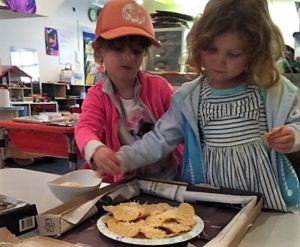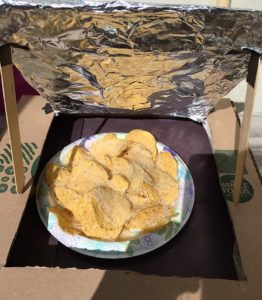Source: matteroftrust.org
Published: August 4, 2016
It’s never too early to learn about solar energy, especially when tasty treats are involved.
The Kids Club preschoolers in San Francisco had a fun time making their solar ovens.

Ovens made, now for the nachos

The solar nacho oven

Today, we are going to become engineers and design our own solar cooker. Can’t wait for the smores to melt!

Yum!
Cooking food with the sun is basically the same as regular oven or stove cooking (not microwave cooking). However, there are three principles of solar cooking that engineers must consider: directing the maximum possible amount of sunlight to the food by reflection, converting sunlight into thermal energy, and holding on to solar heat by using insulation. Also, all solar cookers must be able to absorb as much sunlight as possible. Black pots, pans and dishes are all used in solar cookers to maximize the absorption of light. Some solar cookers have black interior surfaces to maximize conversion of sunlight into thermal energy.

Tasty!
In areas without electricity or gas for energy, people often do not have ovens or stoves for cooking, so engineers design inexpensive solar cookers to help them. Usually, the people in these areas use wood to cook, so the use of solar cookers also saves trees, which reduces deforestation. Deforestation is a big contributor to global warming, habitat destruction and erosion of soil (which leads to flooding and landslides). Solar cookers can also be used to purify water without using wood or fossil fuel resources. Using solar cookers reduces pollution and the emission of greenhouse gases. Using a solar cooker, rather than an oven or stove, does not heat up the house in summer and is inexpensive to build.
